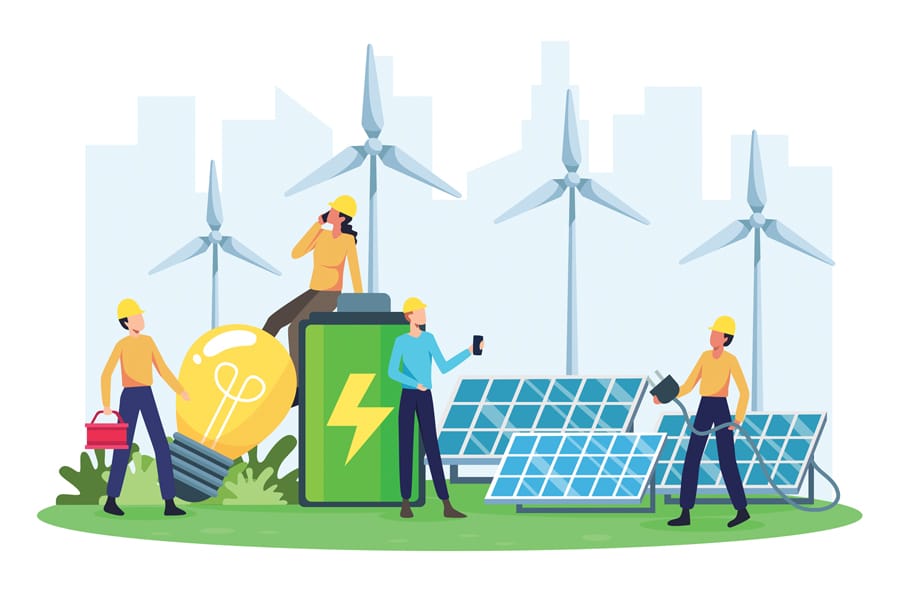Why is sustainability important in construction?
With higher energy costs and greater understanding of the effects of climate change, the urgency for businesses to become more sustainable has risen. For an industry that produces significant carbon emissions, the need for carbon reduction in construction is stronger. More sustainable alternatives are needed for many materials, and construction processes and operational phases are all under the spotlight.
However, while the need is recognised, the understanding around how to reduce carbon emissions in construction is mixed.
With that in mind, Built spoke to Chris Gorse, professor of construction engineering and management at Loughborough University. A follow on from our recent webinar with the CIOB and publication of our guide “The Role of Technology in Sustainability,” the conversation covered some key actions that businesses can take.
Sustainability should be at the heart of any good business
“There are lots of standards and frameworks out there that people can adopt, but they have limited value if they don’t align with your company, the way it operates and what specific benefits you need to achieve,” Gorse explained.
“The most important thing is that companies establish a reliable baseline that can be then used as a benchmark, and then from this position performance can be monitored. Working from a benchmark, organisations can identify issues and patterns, unlock new ways of working and achieve better gains when it comes to sustainability.”
How to promote sustainability in construction and beyond

Gorse suggested that the priority for businesses should be to create a strong economic and environmental model based on less waste and safer, higher-quality sustainable outputs that benefit people and the planet.
“Some people think that all the low-hanging fruit is gone, but there are plenty of steps that organisations can take that don’t cost money,” Gorse said. “Every company will be able to look at their processes and find ways to reduce wastage. There are lots of inefficiencies that can be focused on first—we must eliminate waste, simple areas such as cutting paper and unnecessary package use, reducing energy by switching off appliances and equipment. Smart controls now make it easy to monitor and control heating and lighting, eliminating unnecessary operation. There are so many easy wasteful activities to identify and eliminate. Wasteful use of resource offers no organisational benefit and should be removed. Eliminating waste is useful, brings instant returns and can create opportunity for investment in energy-efficient technologies and processes. Organisations need to rethink their processes, logistics and resource use to become more sustainable, efficient and effective.”
“If companies can do this and embed sustainability at every level, they will be better off and more profitable—the two things shouldn’t be mutually exclusive,” Gorse added.
Driving long-term, sustainable change
One of the challenges of driving any change is finding the time to do it. This is a particular risk when it comes to making organisations more sustainable. With so many options when it comes to new processes, materials and sustainable technologies in construction, finding time becomes essential.
Gorse’s recommendation is that organisations differentiate teams through their activities empowering members to develop sustainable processes. Work packages can be used to clearly define groups. The work packages are important for managing, tackling and monitoring change, innovation and success. When empowered, teams are far better at identifying waste and wasteful processes and developing more efficient methods of operation.
“Teams need time to consider their options and improve their processes so that any changes are effective at all levels,” Gorse explained. “Once done, this should create more resources or money elsewhere that can be used for other things, including investments in more sustainable technology and solutions.”
“Projects and processes need to be worked on over time, and organisations need to accept that some mistakes will happen along the way. The environment is changing rapidly, but that is no excuse to wait. We need to try new things, with monitoring in place so that we can analyse and continuously improve.”
“This is especially important when it comes to existing building stock,” Gorse said. “Not all retrofit strategies will work on all buildings, but we should get to a point where a big proportion of services and products will work off the shelf, aligned with specific building types. Although every building is different, within the building stock, buildings fall into similar typologies with common materials. Once the common building properties are known, typical or mass-produced solutions can be developed. With some thought the sector can move away from the ad hoc, responsive retrofit market to a more effectively developed and targeted process. Once the existing building stock is better understood, then market-driven solutions can be developed. In turn, this will create new jobs, products and services that will improve other parts of the built environment, too.”
Sustainability in construction is a team effort
The challenge to meet net zero will be huge for the construction industry, and companies will not be able to do it on their own. Meeting sustainability targets will involve significant collaboration throughout the whole supply chain and industry partners. It means that the industry needs to be better at communicating with each other, according to Gorse.
“If you don’t communicate with everyone in the supply chain, there is no way that you’re getting to net zero,” Gorse said. “It’s the only way that we can all learn from each other effectively. Others might be delivering quality services, even without the best tech or processes, so you may be able to help them on their own net zero journey. Likewise, you can look at what they’re doing. Pick up on their challenges, look at their measurement and metrics, and try to find the intelligent ideas that can be replicated.”
“Essentially, you are using the value of having a larger group of people to gather insight and ideas from, and filling gaps in knowledge with other experts beyond your own business.”
Gorse concluded that it is the larger companies that should take responsibility for this: “It is the bigger companies that have the buying power and capacity to enact change, both in time and resources. They’ve also got access to the largest part of the industry, which is the huge number of SMEs that deliver work.
“If they can take the lead on research and measurement, and then pass these learnings on and drive better action at a practical level, we’ll see change that is much more effective and in line with the timescales that we need to act within.”
For more information on using sustainable technologies in construction, you can download the guide “The Role of Technology in Sustainability” here. There are also some tips below that will help you along the way to improving your business.
Top tips
- Sustainability guidelines or methodologies should be well established, recognised and adapted for the organization—there is no need to reinvent the wheel
- Improve the business and how it does what it does first—this will inevitability lead to a better performing, more sustainable organisation
- Set up multiple teams to look at smaller areas of improvement first to get the business moving in the right direction and empower the workforce
- Ensure that the right systems are in place to monitor progress
- Work to develop understanding between lab-based and in-situ performance and use research to inform practice
- Renewable energy sources are a must—find ways to bring them into your energy mix for your organisation and for projects











